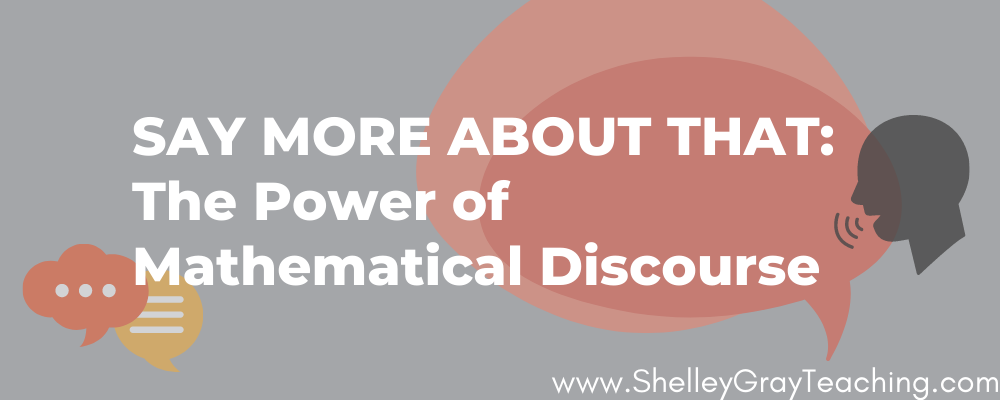
Do you struggle to help your students discuss math concepts at a deep level? Do you feel unsure of where to even start to facilitate this? For a second, I want you to imagine a classroom where deep math learning is accessible to everyone and where students feel comfortable having discussions that level the playing field and deepen their own understanding of math. In their book called The 5 Practices in Practice authors Peg Smith and Miriam Sherin (2019) outline the key practices for facilitating mathematical discourse, while guiding us on how to better implement these meaningful discussions in the Math Lab (or classroom). Encouraging learners to share their thinking out loud with their peers is not only developmentally ideal and more inclusive than other means of instruction and formative assessment but, also creates a stronger community culture that fosters deeper mathematical understanding.
If you read my last blog post on Three Act Math Tasks you know that I believe my role as an educator is to step back and let the learners be the thinkers and the doers.
So, are you ready for another exceptional approach to learning that holds space for the learners rather than the traditional “stand and deliver”?
Ready, Set, Leap!
If you curate your own digital content, you might have come across something called a leap link. As I grow my online presence and expand my understanding of this digital playground called the internet (and finally enter the 21st century), I am amazed at how many cool tools exist solely to help entrepreneurs connect with their community. A leap link is a pro feature you can use to send your audience directly from your socials to what you want them to see rather than having to first sift through a list of your other stuff. The set of books I am reviewing here are like a leap link for Mathematics educators: they jump from an earlier book, 5 Practices for Orchestrating Productive Mathematics Discussions (2018), and instead send you directly to the lived experiences of educators using the five practices.
Alright, so what are these powerful practices and how will they impact your Math classroom?

Table of Contents x3
No matter what level you teach, be it elementary, middle school or high school, learners NEED to talk about math in order to make deeper sense of it. Thus, the National Council for Teachers of Mathematics (NCTM) published three versions of this book each with corresponding tasks and video footage from real classrooms. Though the audience varies, the Tables of Contents are structured the same and each chapter outlines one of the six practices (there is actually a practice zero) and its associated challenges, namely:
- Goal-setting: The importance of linking your planned learning objective with a high-level, “doing-mathematics” task (Practice 0)
- Anticipating: mapping potential learner thinking and preparing accordingly (Practice 1)
- Monitoring: What an educator should do while learners are working (Practice 2)
- Selecting & Sequencing: Crafting a story arc based on learners’ solutions for your congress or consolidation activity (Practices 3 + 4)
- Connecting: linking learners’ work to your task learning objective (Practice 5)
Why is Mathematical Discourse Important in the Math Classroom?
Pro #1 of Mathematical Discourse: Vertical Alignment of Equity
When I compared the first chapter of each version, I found there to be important vertical alignment in terms of the way this approach promotes equity when it comes to access to Math learning. At the elementary level, the authors present this using the example of what Jo Boaler (another wise mentor I found on my Math Hero’s Journey) calls “low floor high ceiling” tasks. Such tasks invite EVERYONE to think but also connect to advanced concepts. In the middle school version, it is argued that “these years impact course-taking options” and therefore it is even more critical that each learner have equitable access to deep learning. Following suit, the high school edition urges us to do away with “high school tracking” and instead deliver activities that open multiple entry points and elevate all learner voices. Here in Ontario, the Mathematics curriculum was revamped in 2020, including such “de-streaming” for Grade 9 learners. It is one small step in avoiding the damage done by sorting learners at that age into Applied and Academic streams. As such, bringing mathematical discourse to the forefront of your teaching approach is critical whether you work with seven-year-olds or seventeen-year-olds, as it levels the playing field.
Pro #2 of Mathematical Discourse: Horizontal Alignment
These books, and the five plus one practices they dissect, demand a lot of opportunities for horizontal alignment as well, acknowledging the difficulty that educators face when implementing the approach. In particular, practices 0 and 1 (planning/goal-setting and anticipating) are time-consuming! Alas, they are the very necessary foundation of meaningful math discussions. In this way, if you work in a school big enough to have multiple staff members planning for the same learning objectives then it is definitely time to buddy up. The honesty that Smith and Sherin deliver by including access to footage from real classrooms is refreshing when contrasted with some of my experiences in this profession where I have felt isolated or that “sink or swim” vibe. Where the five practices are proven to create a better learning culture for the young humans, they present an opportunity for the adult culture of the school to shift too. Teacher efficacy goes up when educators are encouraged to work together and as a result the bravery you might have had to muster before to “open your classroom door” is not needed as much because mistake-making is normalized and everyone is coming together for a common goal: to improve instructional practices and augment learner achievement.

Pro #3: Classroom Culture Improves and Understanding Deepens
In my own experience with facilitating mathematical discourse, it helps to establish your norms and routines first. This past September the learners in my Math Lab used Jo Boaler’s norms as a launching off point to keep or toss and establish the climate they wanted. With my youngest learners, having fun, working together, and working on hard problems were their top three norms. With the nine to eleven-year-olds they agreed it is important to make mistakes, ask for help and to be able to work at your own pace. With both groups I also established a culture of “say more about that” early on, and have critical talk stems like, “Why are our answers different?” posted in the lab. As I have started to present them with increasingly complex but open problems, with an emphasis on sharing thinking and discourse, I have felt privileged to watch some of the emerging mathematicians share creative and accurate solutions before the “proficient” thinkers who usually answer first have shared at all.
The look on the face of a learner who realizes their way of interacting with math is not only correct but also valuable to others is the stuff that brings tears of joy to my eyes.
Not Just A Book Review, A Book Recommendation
I would recommend this book to anyone involved in Mathematics education for many different reasons. If you are a classroom educator at any level, this set of routines will open up and improve the culture of your math community. If you are a team lead or math coach, the opportunity for group reading and engagement is built in. There are concrete before, during and after activities in each chapter which prompt us to reflect on our current approach, analyze real examples, and then implement in our own work. If you work in school administration and are concerned with making deep math learning accessible to ALL of your students in the form of equity and inclusion, then mathematical discourse is a must-have.
Bottom line: these books are a must-read if you want to get your learners talking, deepen their (and your own) understanding of math and watch your classroom community blossom as a result. If you don’t have the bandwidth right now for a complete overhaul of your current long range plans, or even an à la carte/once a week extra serving of front-loaded planning (I get it) you might want to get started instead by introducing a shorter number talk or math conversation routine with your learners.
Resources
For the readers:
- Elementary: https://www.nctm.org/Store/Products/The-5-Practices-in-Practice–Successfully-Orchestrating-Mathematical-Discussion-in-your-Elementary-School-Classroom/
- Middle School: https://www.nctm.org/Store/Products/The-5-Practices-in-Practice–Successfully-Orchestrating-Mathematical-Discussion-in-your-Middle-School-Classroom/
- High School: https://www.nctm.org/Store/Products/The-5-Practices-in-Practice–Successfully-Orchestrating-Mathematics-Discussions-in-Your-High-School-Classroom/
For the grab and goers:
Elementary Tasks to facilitate discussion: https://resources.corwin.com/5practices-elementary/student-resources/tasks
Middle School Tasks: https://resources.corwin.com/5practices-middleschool/student-resources/tasks
High School Tasks: https://resources.corwin.com/5practices-highschool/student-resources/tasks







